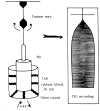Intraoperative changes in blood coagulation and thrombelastographic monitoring in liver transplantation
- PMID: 3896028
- PMCID: PMC2979326
Intraoperative changes in blood coagulation and thrombelastographic monitoring in liver transplantation
Abstract
The blood coagulation system of 66 consecutive patients undergoing consecutive liver transplantations was monitored by thrombelastograph and analytic coagulation profile. A poor preoperative coagulation state, decrease in levels of coagulation factors, progressive fibrinolysis, and whole blood clot lysis were observed during the preanhepatic and anhepatic stages of surgery. A further general decrease in coagulation factors and platelets, activation of fibrinolysis, and abrupt decrease in levels of factors V and VIII occurred before and with reperfusion of the homograft. Recovery of blood coagulability began 30-60 min after reperfusion of the graft liver, and coagulability had returned toward baseline values 2 hr after reperfusion. A positive correlation was shown between the variables of thrombelastography and those of the coagulation profile. Thrombelastography was shown to be a reliable and rapid monitoring system. Its use was associated with a 33% reduction of blood and fluid infusion volume, whereas blood coagulability was maintained without an increase in the number of blood product donors.
Figures




References
MeSH terms
Grants and funding
LinkOut - more resources
Full Text Sources
Other Literature Sources
Medical

